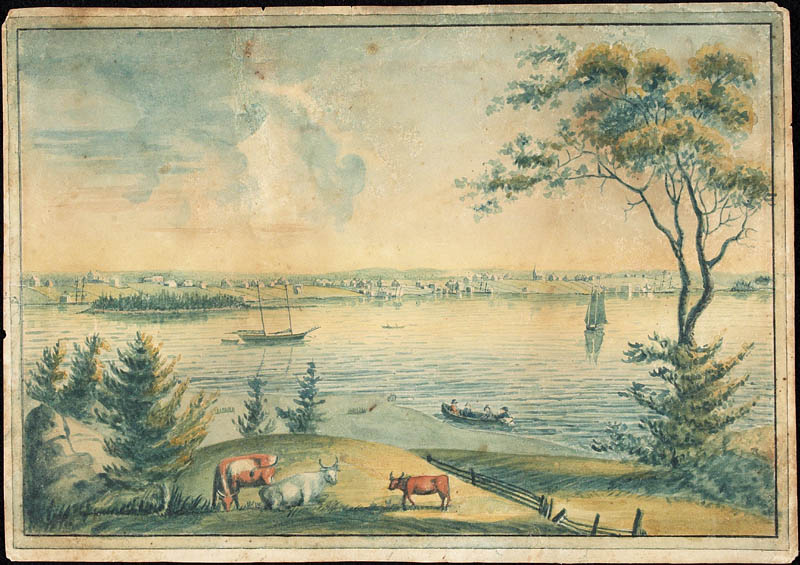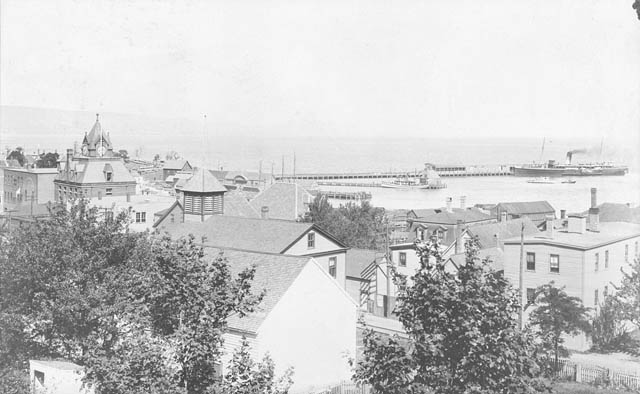|
Thomas Killam
Thomas Killam (February 8, 1802 – December 15, 1868) was a Nova Scotia shipbuilder and political figure. He represented Yarmouth as an Anti-Confederate member from 1867 to 1868. Biography Early life He was born in Yarmouth, Nova Scotia in 1802, the son of a shipbuilder there, and built his first ship, a schooner, in 1839. He built a number of ships for the fisheries and owned or part-owned about 60 ships by 1865. He was also involved in the trade of goods between North America and Britain. In 1837, Killam became a director of the Yarmouth Marine Insurance Association; he was also a director of the Bank of Yarmouth from 1863 to 1868 and of the Yarmouth Academy. Political career He was elected to the General Assembly of Nova Scotia for Yarmouth County in 1847 as a Reformer and served on the public accounts committee as a member and later chairman. He opposed public ownership of utilities; he was part of a private group that took over ownership of the Nova Scotia Electric Tele ... [...More Info...] [...Related Items...] OR: [Wikipedia] [Google] [Baidu] |
Yarmouth, Nova Scotia
Yarmouth is a town in southwestern Nova Scotia, Canada. A port town, industries include fishing, and tourism. It is the terminus of a ferry service to Bar Harbor, Maine, run by Bay Ferries. History Originally inhabited by the Mi'kmaq, the region was known as "Keespongwitk" meaning "Lands End" due to its position at the tip of the Nova Scotia peninsula. European settlement The region was visited in 1604 by Samuel de Champlain, who named it "Cap-Fourchu", meaning "forked or cloven cape." The first Europeans to make a settlement on these shores were the French Acadians. They set up a small fishing settlement known as "Tebouque" in the mid 1600s and by 1750 the population was 50 people. During the Seven Years' War, New England Planters settled at what is now the town of Yarmouth in 1759; the grantees were from Yarmouth, Massachusetts and they requested that Yarmouth be named after their former home. Yarmouth was founded on June 9, 1761, when a ship carrying three families arriv ... [...More Info...] [...Related Items...] OR: [Wikipedia] [Google] [Baidu] |
Yarmouth County, Nova Scotia
Yarmouth County is a rural county in the Canadian province of Nova Scotia. It has both traditional Anglo- Scottish and Acadian French culture as well as significant inland wilderness areas, including over 365 lakes and several major rivers. It comprises three municipalities: the Town of Yarmouth, the Municipality of the District of Yarmouth, and the Municipality of the District of Argyle. History The name Yarmouth first appeared as a projected township in Nova Scotia in 1759. There is some speculation it was named after Yarmouth, Massachusetts, as some of the earliest English settlers arrived from Cape Cod on 9 June 1761. It is more likely the township was named after Lady Yarmouth, a mistress of King George II. Originally the area was part of Lunenburg County. In 1761 it became part of Queens County; in 1784 it became part of Shelburne County and finally became a county on its own in 1836. The description of Yarmouth County was modified in 1846. It was then divided into ... [...More Info...] [...Related Items...] OR: [Wikipedia] [Google] [Baidu] |
Politicians From Yarmouth, Nova Scotia
A politician is a person active in party politics, or a person holding or seeking an elected office in government. Politicians propose, support, reject and create laws that govern the land and by an extension of its people. Broadly speaking, a politician can be anyone who seeks to achieve political power in a government. Identity Politicians are people who are politically active, especially in party politics. Political positions range from local governments to state governments to federal governments to international governments. All ''government leaders'' are considered politicians. Media and rhetoric Politicians are known for their rhetoric, as in speeches or campaign advertisements. They are especially known for using common themes that allow them to develop their political positions in terms familiar to the voters. Politicians of necessity become expert users of the media. Politicians in the 19th century made heavy use of newspapers, magazines, and pamphlets, as well ... [...More Info...] [...Related Items...] OR: [Wikipedia] [Google] [Baidu] |
Nova Scotia Anti-Confederation Party MLAs
A nova (plural novae or novas) is a transient astronomical event that causes the sudden appearance of a bright, apparently "new" star (hence the name "nova", which is Latin for "new") that slowly fades over weeks or months. Causes of the dramatic appearance of a nova vary, depending on the circumstances of the two progenitor stars. All observed novae involve white dwarfs in close binary systems. The main sub-classes of novae are classical novae, recurrent novae (RNe), and dwarf novae. They are all considered to be cataclysmic variable stars. Classical nova eruptions are the most common type. They are likely created in a close binary star system consisting of a white dwarf and either a main sequence, subgiant, or red giant star. When the orbital period falls in the range of several days to one day, the white dwarf is close enough to its companion star to start drawing accreted matter onto the surface of the white dwarf, which creates a dense but shallow atmosphere. This atmosp ... [...More Info...] [...Related Items...] OR: [Wikipedia] [Google] [Baidu] |
1868 Deaths
Events January–March * January 2 – British Expedition to Abyssinia: Robert Napier leads an expedition to free captive British officials and missionaries. * January 3 – The 15-year-old Mutsuhito, Emperor Meiji of Japan, declares the '' Meiji Restoration'', his own restoration to full power, under the influence of supporters from the Chōshū and Satsuma Domains, and against the supporters of the Tokugawa shogunate, triggering the Boshin War. * January 5 – Paraguayan War: Brazilian Army commander Luís Alves de Lima e Silva, Duke of Caxias enters Asunción, Paraguay's capital. Some days later he declares the war is over. Nevertheless, Francisco Solano López, Paraguay's president, prepares guerrillas to fight in the countryside. * January 7 – The Arkansas constitutional convention meets in Little Rock. * January 9 – Penal transportation from Britain to Australia ends, with arrival of the convict ship '' Hougoumont'' in Wester ... [...More Info...] [...Related Items...] OR: [Wikipedia] [Google] [Baidu] |
1802 Births
Eighteen or 18 may refer to: * 18 (number), the natural number following 17 and preceding 19 * one of the years 18 BC, AD 18, 1918, 2018 Film, television and entertainment * ''18'' (film), a 1993 Taiwanese experimental film based on the short story ''God's Dice'' * ''Eighteen'' (film), a 2005 Canadian dramatic feature film * 18 (British Board of Film Classification), a film rating in the United Kingdom, also used in Ireland by the Irish Film Classification Office * 18 (''Dragon Ball''), a character in the ''Dragon Ball'' franchise * "Eighteen", a 2006 episode of the animated television series '' 12 oz. Mouse'' Music Albums * ''18'' (Moby album), 2002 * ''18'' (Nana Kitade album), 2005 * '' 18...'', 2009 debut album by G.E.M. Songs * "18" (5 Seconds of Summer song), from their 2014 eponymous debut album * "18" (One Direction song), from their 2014 studio album ''Four'' * "18", by Anarbor from their 2013 studio album ''Burnout'' * "I'm Eighteen", by Alice Cooper comm ... [...More Info...] [...Related Items...] OR: [Wikipedia] [Google] [Baidu] |
Canadian Confederation
Canadian Confederation (french: Confédération canadienne, link=no) was the process by which three British North American provinces, the Province of Canada, Nova Scotia, and New Brunswick, were united into one federation called the Dominion of Canada, on July 1, 1867. Upon Confederation, Canada consisted of four provinces: Ontario and Quebec, which had been split out from the Province of Canada, and the provinces of Nova Scotia and New Brunswick. Over the years since Confederation, Canada has seen numerous territorial changes and expansions, resulting in the current number of ten provinces and three territories. Terminology Canada is a federation and not a confederate association of sovereign states, which is what " confederation" means in contemporary political theory. It is nevertheless often considered to be among the world's more decentralized federations. The use of the term ''confederation'' arose in the Province of Canada to refer to proposals beginning in the 1850 ... [...More Info...] [...Related Items...] OR: [Wikipedia] [Google] [Baidu] |
Joseph Howe
Joseph Howe (December 13, 1804 – June 1, 1873) was a Nova Scotian journalist, politician, public servant, and poet. Howe is often ranked as one of Nova Scotia's most admired politicians and his considerable skills as a journalist and writer have made him a provincial legend. He was born the son of John Howe and Mary Edes at Halifax and inherited from his loyalist father an undying love for Great Britain and her Empire. At age 23, the self-taught but widely read Howe purchased the '' Novascotian'', soon making it into a popular and influential newspaper. He reported extensively on debates in the Nova Scotia House of Assembly and travelled to every part of the province writing about its geography and people. In 1835, Howe was charged with seditious libel, a serious criminal offence, after the ''Novascotian'' published a letter attacking Halifax politicians and police for pocketing public money. Howe addressed the jury for more than six hours, citing example after example of c ... [...More Info...] [...Related Items...] OR: [Wikipedia] [Google] [Baidu] |
Kingdom Of Great Britain
The Kingdom of Great Britain (officially Great Britain) was a sovereign country in Western Europe from 1 May 1707 to the end of 31 December 1800. The state was created by the 1706 Treaty of Union and ratified by the Acts of Union 1707, which united the kingdoms of England (which included Wales) and Scotland to form a single kingdom encompassing the whole island of Great Britain and its outlying islands, with the exception of the Isle of Man and the Channel Islands. The unitary state was governed by a single parliament at the Palace of Westminster, but distinct legal systems – English law and Scots law – remained in use. The formerly separate kingdoms had been in personal union since the 1603 "Union of the Crowns" when James VI of Scotland became King of England and King of Ireland. Since James's reign, who had been the first to refer to himself as "king of Great Britain", a political union between the two mainland British kingdoms had been repeatedly attempted and ... [...More Info...] [...Related Items...] OR: [Wikipedia] [Google] [Baidu] |
Digby, Nova Scotia
Digby is an incorporated town in southwestern Nova Scotia, Canada. It is in the historical county of Digby and a separate municipality from the Municipality of the District of Digby. The town is situated on the western shore of the Annapolis Basin near the entrance to the Digby Gut, which connects the basin to the Bay of Fundy. Named after Admiral Robert Digby, the town has a scallop fishing fleet. The MV ''Fundy Rose'' ferry service connects the town to Saint John, New Brunswick. History Digby is called Oositookun, meaning ear of land, by the Mi'kmaq. A small group of New England Planters settled in the area of the town in the 1760s naming it Conway. However Digby was formally settled and surveyed as a town in June 1783 by the United Empire Loyalists under the leadership of Sir Robert Digby. The town developed a sizable shipping fleet in the 19th century. One famous Digby vessel was the brigantine ''Dei Gratia'', which discovered the famous mystery ship '' Mary Celeste'' ... [...More Info...] [...Related Items...] OR: [Wikipedia] [Google] [Baidu] |
Schooner
A schooner () is a type of sailing vessel defined by its rig: fore-and-aft rigged on all of two or more masts and, in the case of a two-masted schooner, the foremast generally being shorter than the mainmast. A common variant, the topsail schooner also has a square topsail on the foremast, to which may be added a topgallant. Differing definitions leave uncertain whether the addition of a fore course would make such a vessel a brigantine. Many schooners are gaff-rigged, but other examples include Bermuda rig and the staysail schooner. The origins of schooner rigged vessels is obscure, but there is good evidence of them from the early 17th century in paintings by Dutch marine artists. The name "schooner" first appeared in eastern North America in the early 1700s. The name may be related to a Scots word meaning to skip over water, or to skip stones. The schooner rig was used in vessels with a wide range of purposes. On a fast hull, good ability to windward was useful for pri ... [...More Info...] [...Related Items...] OR: [Wikipedia] [Google] [Baidu] |




.png)

